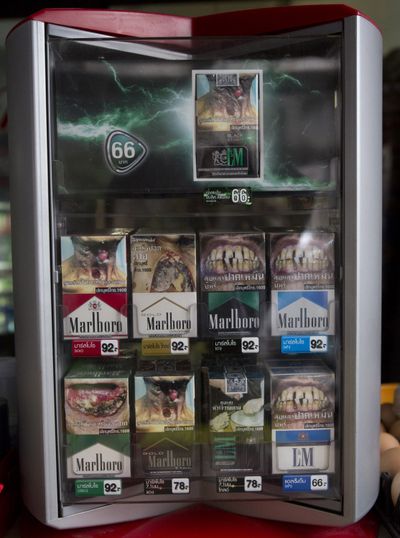More countries adding graphic warnings to packs of cigarettes

JAKARTA, Indonesia – Indonesia became the newest country to mandate graphic photo warnings on cigarette packs on Tuesday, joining more than 40 other nations or territories that have adopted similar regulations in recent years. The warnings, which showcase gruesome close-up images ranging from rotting teeth and cancerous lungs to open tracheotomy holes and corpses, are an effort to highlight the risks of health problems related to smoking. Research suggests these images have prompted people to quit, but the World Health Organization estimates nearly 6 million people continue to die globally each year from smoking-related causes. The tobacco industry has fought government efforts to introduce or increase the size of graphic warnings in some countries. Here are a few places where pictorial health warnings have made headlines:
Indonesia
THE LAW: 40 percent of pack covered by graphic photos.
TIMING: Deadline to be on shelves was Tuesday.
BACKGROUND: Many tobacco companies missed the deadline to comply with the new law requiring all cigarette packs in stores to carry graphic warning photos. Indonesia, a country of around 240 million, has the world’s highest rate of male smokers at 67 percent and the second-highest rate overall. Its government is among the few that has yet to sign a World Health Organization treaty on tobacco control.
Thailand
THE LAW: Portion of cigarette packs that must be covered with graphic health warnings rising from 55 percent to 85 percent.
TIMING: Change will take effect in September.
BACKGROUND: Last year, the Public Health Ministry issued a regulation increasing the level of coverage to 85 percent. Tobacco giant Philip Morris and more than 1,400 Thai retailers sued, and a court temporarily suspended the order. On Thursday, the Supreme Administrative Court ruled that the regulation can take effect before a lower court reaches a final verdict in the lawsuit.
Philippines
THE LAW: Graphic warning legislation approved this month requires 50 percent of the bottom of the pack to be covered by graphic warnings.
TIMING: Legislation awaits president’s signature.
BACKGROUND: The Philippines is expected to join a handful of other countries that put graphic warnings at the bottom of their packs, meaning they are not visible when displayed on store shelves. Anti-smoking advocates say labels on the bottom of the packs are less effective and have denounced tobacco industry involvement in the implementation process. Health officials said around 17 million people in the country of 96 million, or 18 percent, smoked in 2012.
Uruguay
THE LAW: Graphic warnings cover 80 percent of packs.
TIMING: Regulations implemented in 2010.
BACKGROUND: Uruguay, a leader in strict tobacco controls, mandated what were the largest graphic warnings ever in 2010. Eighty percent of packs must be covered by the labels, including one depicting a person smoking a battery to show that cigarettes contain the toxic metal cadmium. Uruguay has backed Australia at the World Trade Organization, telling the trade body that smoking is “the most serious pandemic confronting humanity.” Philip Morris International sued Uruguay over the law; the case is still pending.